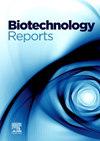普鲁兰毛霉发酵产胞外多糖的迭代统计优化方法
Q1 Immunology and Microbiology
引用次数: 0
摘要
胞外多糖是一种具有广泛工业应用的生物聚合物。为了用生物基、可生物降解的聚合物代替化石基,外多糖的生产需要变得更加高效。普鲁兰是由普鲁兰毛霉(Aureobasidium pululans)生产的,因其成膜性、粘附性、可生物降解性等独特特性而广受欢迎。本研究旨在利用统计优化迭代法论证普鲁兰生产的优化策略。该过程遵循系统的方法,包括一次一个因素(OFAT)和实验设计(DOE)。OFAT确定蔗糖为碳源,pH为6,培养4 d为最佳。迭代Plackett-Burman设计(PBD)和响应面法(RSM)进一步证明了重要培养基成分与孵卵条件之间的相互作用。最终的普鲁兰滴度提高了6.34倍,达到113.5±3.5 g/L EPS,是该菌株在摇瓶中获得的最高滴度。未来可以探索饲料批量策略和规模研究,以进一步提高滴度并降低总体生产成本。本文章由计算机程序翻译,如有差异,请以英文原文为准。
An iterative approach to statistical optimization of exopolysaccharide produced by fermentation of Aureobasidium pullulans
Exopolysaccharides are biopolymers with wide-ranging industrial applications. To substitute fossil-based by bio-based, biodegradable polymers, exopolysaccharide production needs to become much more efficient. Pullulan, produced by Aureobasidium pullulans, is popular for its unique properties like film-formation, adhesiveness, biodegradability, etc. This study aims at demonstrating the optimization strategy on pullulan production using statistical optimization iteratively. The process followed a systematic approach including One Factor at A Time (OFAT) and Design Of Experiments (DOE). OFAT confirmed sucrose as carbon source, pH 6 and 4 days of incubation were optimum. Iterative Plackett-Burman Design (PBD) and Response Surface Methodology (RSM) further demonstrated interactions between significant media components and incubation conditions. The final pullulan titer was increased 6.34-fold to 113.5 ± 3.5 g/L of EPS, the highest titer achieved for this strain in shake flasks. Future investigations into fed-batch strategies and scale-up studies can be explored to further improve titers and reduce overall production costs.
求助全文
通过发布文献求助,成功后即可免费获取论文全文。
去求助
来源期刊

Biotechnology Reports
Immunology and Microbiology-Applied Microbiology and Biotechnology
CiteScore
15.80
自引率
0.00%
发文量
79
审稿时长
55 days
期刊介绍:
Biotechnology Reports covers all aspects of Biotechnology particularly those reports that are useful and informative and that will be of value to other researchers in related fields. Biotechnology Reports loves ground breaking science, but will also accept good science that can be of use to the biotechnology community. The journal maintains a high quality peer review where submissions are considered on the basis of scientific validity and technical quality. Acceptable paper types are research articles (short or full communications), methods, mini-reviews, and commentaries in the following areas: Healthcare and pharmaceutical biotechnology Agricultural and food biotechnology Environmental biotechnology Molecular biology, cell and tissue engineering and synthetic biology Industrial biotechnology, biofuels and bioenergy Nanobiotechnology Bioinformatics & systems biology New processes and products in biotechnology, bioprocess engineering.
 求助内容:
求助内容: 应助结果提醒方式:
应助结果提醒方式:


